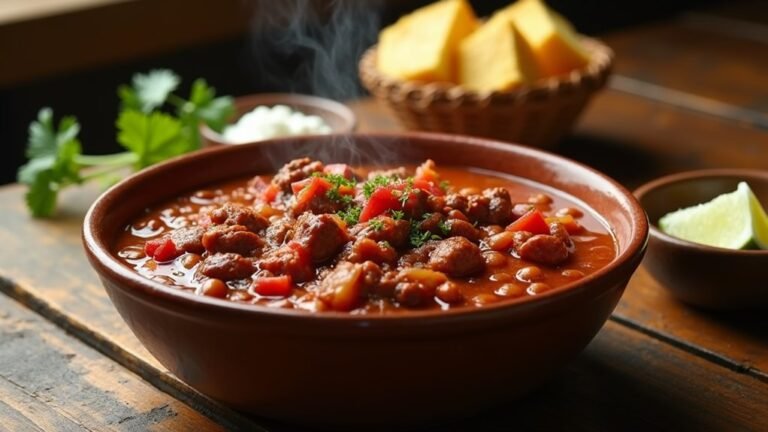Aloo Gobi Recipe: Classic Indian Comfort Food
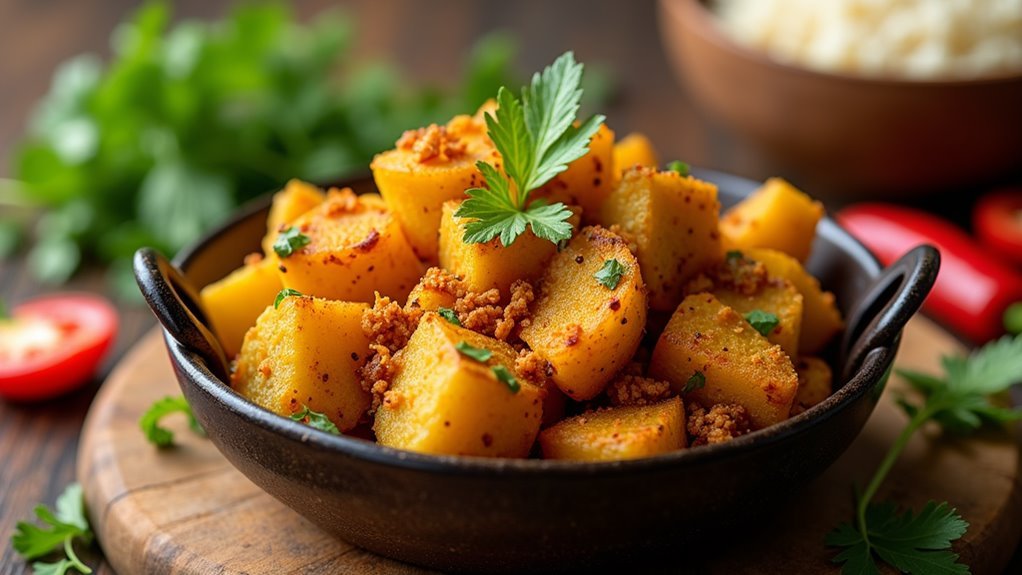
Picture yourself in a bustling Mumbai kitchen, filled with the aroma of Aloo Gobi, a cherished Indian dish. This simple combination of potatoes, cauliflower, and curry powder offers endless possibilities for variation.
Heating oil with spices unlocks profound flavors, transforming your dinner into a culinary journey. This straightforward recipe warms the soul and serves as both a quick weeknight meal and a memorable side dish for special gatherings.
Key Takeaways
- Aloo Gobi is a classic Indian dish made with potatoes and cauliflower.
- The dish is flavored with curry powder for a rich, aromatic taste.
- It can be served as a main dish or a side with rice or flatbread.
- Cooking involves blooming spices, sautéing vegetables, and steaming for tenderness.
- The recipe is vegetarian, simple to prepare, and perfect for quick meals.
Recipe
Aloo Gobi is a quintessential Indian dish that combines potatoes and cauliflower into a harmonious blend of textures and flavors. This simplified version aims to capture the essence of the traditional recipe while keeping the process straightforward and accessible. The dish is infused with the warm, aromatic notes of curry powder, making it a delightful vegetarian option that pairs well with rice or flatbread.
The beauty of Aloo Gobi lies in its simplicity and versatility. By using just a few core ingredients, you can create a satisfying meal that's both comforting and flavorful. This minimalist approach enhances the natural taste of the vegetables, allowing the spices to shine through without overwhelming the dish. It's a perfect choice for a quick weeknight dinner or a hearty side dish for a larger meal.
Ingredients:
- 2 medium potatoes, cubed
- 1 medium cauliflower, cut into florets
- 3 tablespoons vegetable oil
- 2 teaspoons curry powder
- 1 teaspoon salt
To prepare this dish, start by heating the vegetable oil in a large skillet over medium heat. Add the curry powder to the hot oil and let it bloom for about 30 seconds, releasing its fragrance.
Next, add the cubed potatoes and cook them for approximately 5 minutes, stirring occasionally to ensure even browning. After the potatoes start to soften, add the cauliflower florets and salt. Cover the skillet and cook for 15-20 minutes, stirring every few minutes. The goal is to achieve tender potatoes that can be easily pierced with a fork and cauliflower that retains some bite while being cooked through.
If the vegetables begin to stick to the pan, add a splash of water to deglaze and release the flavorful browned bits.
For the best results, ensure the potatoes and cauliflower are cut into similarly sized pieces to promote even cooking. Adjust the amount of curry powder to suit your taste preferences. If you prefer a spicier dish, consider adding a pinch of red chili powder or freshly grated ginger for an extra kick.
Serve the Aloo Gobi hot as a main dish with rice or flatbread, or as a side to complement a larger spread.
Cooking Steps
Get ready to bring your Aloo Gobi to life with some simple yet flavorful cooking steps!
Start by heating oil with curry powder in a large skillet, letting the spices release their aromatic magic, then add the potato cubes and cook for five minutes.
Next, toss in the cauliflower and salt, cover the pan, and cook until both vegetables are tender, stirring occasionally to ensure everything cooks evenly and blends beautifully.
Step 1. Heat Oil With Curry Powder
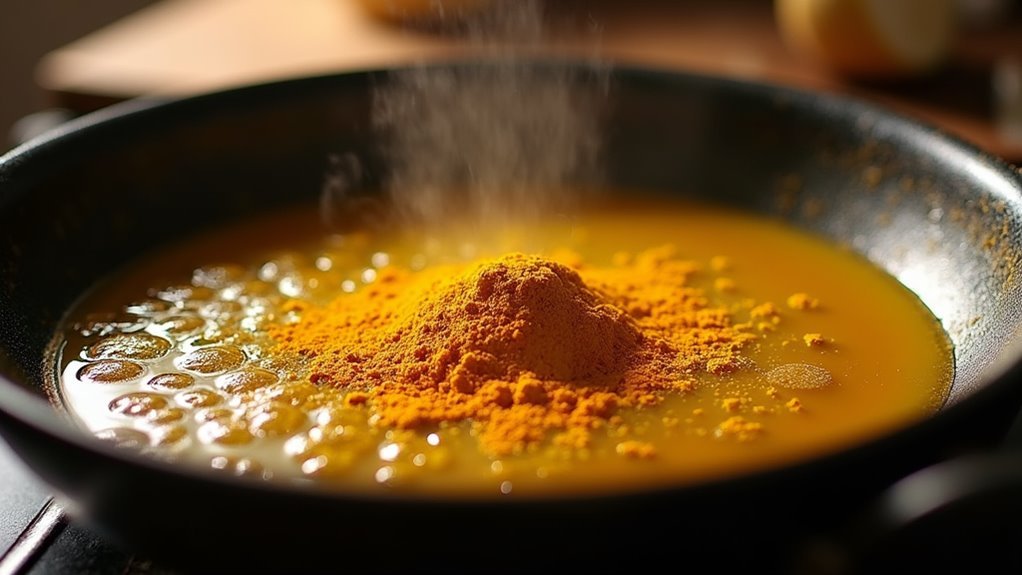
To begin the cooking process, you'll frequently want to heat the oil in a large skillet over medium heat. This step is crucial as it serves as the foundation for the flavors to come.
Once the oil is shimmering, add the curry powder, and watch the magic happen! The spices will release their aromatic goodness, filling your kitchen with a warm, inviting scent that hints at the delicious dish you'll soon enjoy.
Stir the curry powder gently for about 30 seconds, allowing it to bloom and infuse the oil with its distinct flavor. This simple step elevates the dish, creating a rich base that enhances the potatoes and cauliflower.
You'll be amazed at how such a small action transforms the entire recipe!
Step 2. Add Potatoes, Cook Five Minutes
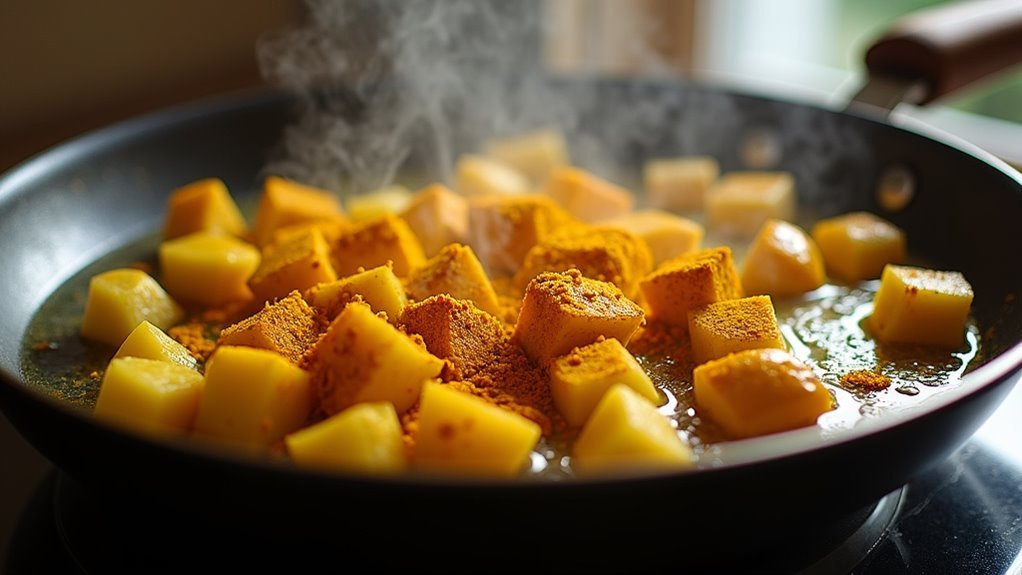
Once the curry powder has infused the oil, it's time to introduce the potatoes into the skillet.
Feel the excitement as you drop those potato cubes into the sizzling seasoned oil, watching them soak up that rich, aromatic flavor. Stir them occasionally, making sure they're coated evenly with the spices.
Let them cook for about five minutes, turning golden and starting to soften. You'll notice a delicious fragrance filling your kitchen, signaling the start of something amazing.
This step is crucial for building the base of your Aloo Gobi, ensuring each bite will be packed with flavor. Keep the potatoes moving to prevent sticking, and get ready to add the next layer of deliciousness soon.
Enjoy this simple yet delightful process!
Step 3. Add Cauliflower and Salt
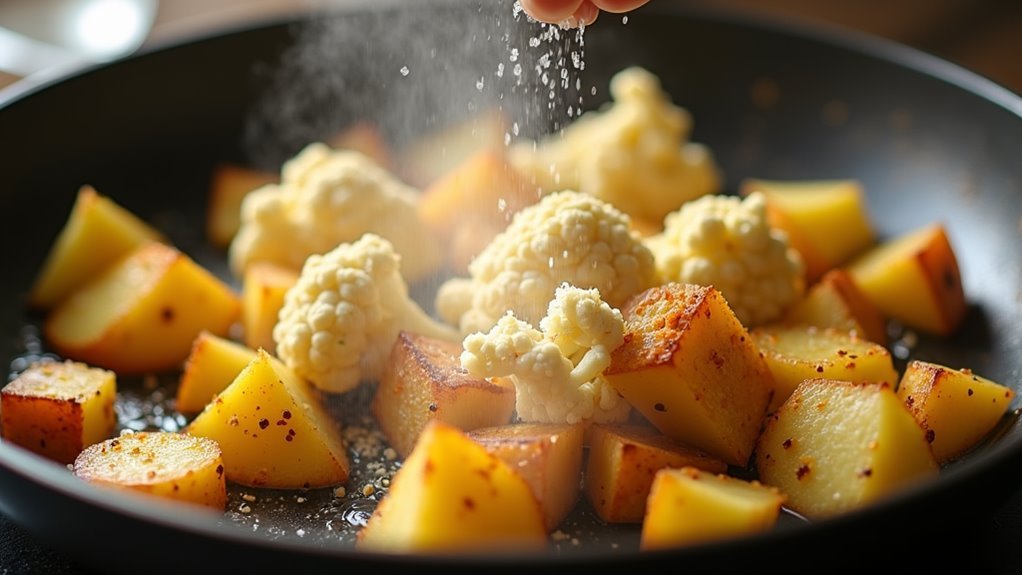
With the potatoes starting to turn golden and fragrant, it's time to introduce the cauliflower florets to the skillet. This step is where your Aloo Gobi truly begins to take shape.
Toss in the cauliflower, ensuring each floret gets its share of the sizzling oil and spices. Sprinkle in the salt, which not only enhances the flavors but also helps the cauliflower cook evenly.
You'll want to give everything a good stir, making sure the potatoes and cauliflower mingle well with the spices. The aroma that fills your kitchen at this point is nothing short of inviting.
It's a simple process, yet it transforms these humble vegetables into a deeply satisfying dish. You're crafting something special, and it's utterly delicious.
Step 4. Cover, Cook Until Tender
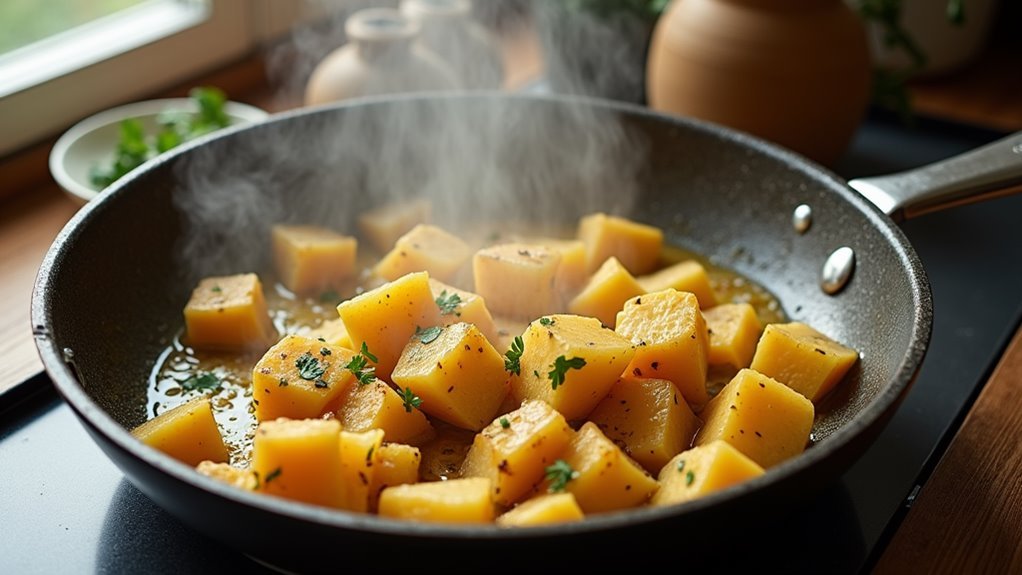
Now that the cauliflower and potatoes are well-coated in the fragrant spices, it's time to cover the skillet and let the magic happen.
As you place the lid on, you're setting the stage for the flavors to meld beautifully. Over the next 15-20 minutes, the steam trapped inside will soften the vegetables, allowing them to absorb the aromatic spices fully.
The potatoes will become tender, while the cauliflower retains a delightful bite. Keep the heat steady, but not too high, to prevent the spices from burning.
If you notice the vegetables sticking, a splash of water can help release them. This cooking method ensures that every bite of your Aloo Gobi is packed with flavor, offering a comforting and satisfying experience.
Step 5. Stir Occasionally for Tenderness
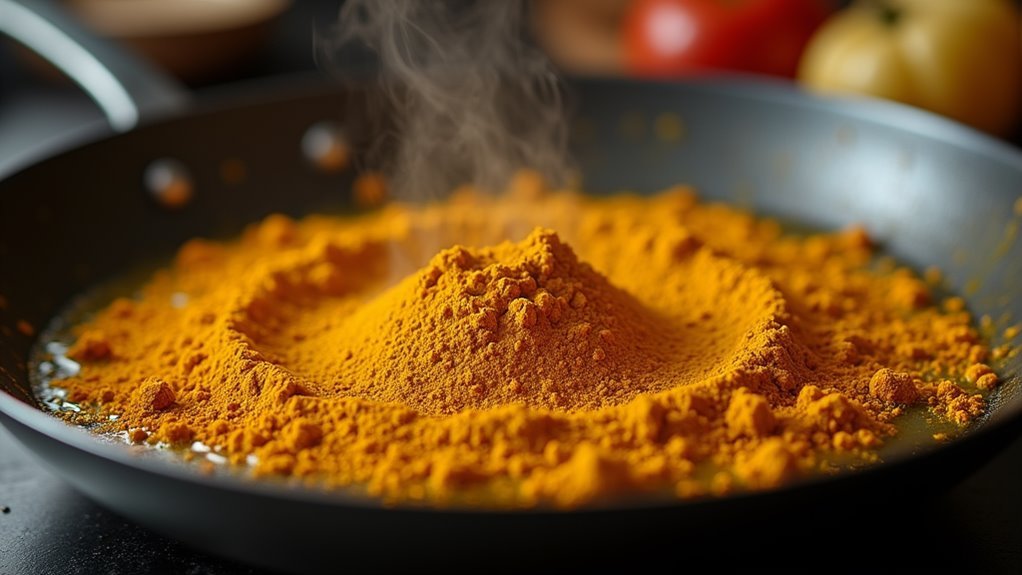
As the vegetables cook under the lid, it's important to give them a gentle stir every few minutes to ensure even tenderness. This simple step helps prevent any sticking to the pan, allowing the potatoes and cauliflower to soak up all those delicious flavors.
You'll notice how the curry powder infuses its vibrant aroma into the mix, making your kitchen smell irresistible. Stirring occasionally is key to achieving that perfect texture, where the potatoes are soft yet firm, and the cauliflower retains a slight bite.
Don't hesitate to add a splash of water if the vegetables begin to stick. This action not only prevents burning but also creates a flavorful steam that enhances the dish.
Final Thoughts
Ultimately, Aloo Gobi is more than just a dish; it's a comforting reminder of the richness in simplicity.
When you embrace this recipe, you're not just cooking—you're connecting with a tradition that values flavor and nourishment. The process is straightforward, yet each step fills your kitchen with enticing aromas, inviting you to savor every moment.
Don't be intimidated by the simplicity; instead, relish the opportunity to create something delicious and satisfying with just a few ingredients.
As you stir occasionally, watching the vegetables turn tender and golden, you'll feel a sense of accomplishment.
Serve your Aloo Gobi with warm rice or flatbread, and you'll experience the joy of homemade comfort food.
Dive in, and let this classic dish become a staple in your kitchen.
Frequently Asked Questions
Can I Use Sweet Potatoes Instead of Regular Potatoes in Aloo Gobi?
Absolutely, you can use sweet potatoes instead of regular potatoes in aloo gobi!
Think of it as adding a sweet twist to a classic tune. Sweet potatoes bring a lovely, natural sweetness that pairs beautifully with the aromatic spices.
Just remember, they cook a bit faster, so keep an eye on them to prevent overcooking.
This swap might just become your new favorite, offering a delightful contrast with the cauliflower!
Enjoy experimenting!
How Do I Store Leftovers, and How Long Do They Last?
To store your delicious leftovers, place them in an airtight container and refrigerate.
They'll stay fresh and flavorful for about 3 to 4 days. If you're planning to keep them longer, freeze them for up to a month.
Reheat in a pan over medium heat, adding a splash of water to prevent sticking, or use a microwave.
This ensures you can enjoy that comforting taste anytime you crave it!
Is It Possible to Make This Dish Without Oil?
Absolutely, you can make this dish without oil!
Simply steam the potatoes and cauliflower until they're tender. Then, toss them with your curry powder and salt.
For added flavor, try roasting the spices in a dry pan first to release their aroma. This technique doesn't compromise taste and keeps things light and healthy.
Give it a try and enjoy a delicious, oil-free version of this beloved dish!
What Can I Substitute for Curry Powder if Unavailable?
If you don't have curry powder, don't worry, you can easily create a substitute using common spices!
Mix equal parts of ground cumin, coriander, and turmeric. For a little heat, add a pinch of cayenne pepper or paprika.
This blend will bring a warm, aromatic kick to your dish. It's exciting to experiment with flavors, so feel free to adjust based on your taste preferences and enjoy the cooking adventure!
Can I Add Other Vegetables to the Aloo Gobi Recipe?
Absolutely, you can transform your Aloo Gobi into a vibrant canvas of flavors by adding other vegetables!
Imagine the burst of color and taste when you toss in peas or carrots, enhancing the dish's harmony.
Chop them into similar-sized pieces, ensuring they cook evenly with the potatoes and cauliflower.
This simple tweak elevates your meal, inviting you to explore new textures and flavors.
Dive in and savor the creative possibilities!





